| Article ID | Journal | Published Year | Pages | File Type |
|---|---|---|---|---|
| 1952203 | Biochimie | 2011 | 7 Pages |
Within the voltage-gated calcium channels (Cav channels) family, there are four genes coding for the L-type Cav channels (Cav1). The Cav1 channels underly many important physiological functions like excitation–contraction coupling, hormone secretion, neuronal excitability and gene transcription. Mutations found in the genes encoding the Cav channels define a wide variety of diseases called calcium channelopathies and all four genes coding the Cav1 channels are carrying such mutations. L-type calcium channelopathies include muscular, neurological, cardiac and vision syndromes. Among them, the Timothy syndrome (TS) is linked to missense mutations in CACNA1C, the gene that encodes the Cav1.2 subunit. Here we review the important features of the Cav1 channelopathies. We also report on the specific properties of TS–Cav1.2 channels, which display non-inactivating calcium current as well as higher plasma membrane expression. Overall, we conclude that both electrophysiological and surface expression properties must be investigated to better account for the functional consequences of mutations linked to calcium channelopathies.
► We describe the properties of a Timothy syndrome (TS) mutation of Cav1.2 channels. ► Recombinant TS–Cav1.2 channels were expressed with various β subunit isotypes. ► TS–Cav1.2 channels display similar non-inactivating calcium current in all conditions. ► We find higher membrane expression of TS–Cav1.2 channels, compared to wt channels. ► We conclude that the TS G406R mutation intrinsically affects inactivation and surface expression of Cav1.2 channels.
